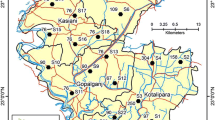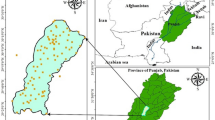Abstract
In the present study, the water quality status of the Sadar block in Pratapgarh district of Uttar Pradesh, India, was calculated by Water Pollution Index (WPI) using 15 groundwater quality parameters (pH, turbidity, EC (electric conductivity), TDS (total dissolved solids), salinity, total hardness, Ca2+, K+, Mg2+, Na+, Cl−, F−, SO42−, HCO3−, and NO3−) at 40 different study locations. It is found that 10%, 25%, and 65%, of samples, fall under the good, moderately polluted, and highly polluted category, respectively. Irrigation suitability of groundwater has also been evaluated by using irrigation suitability parameters, i.e., Sodium Absorption Ratio (SAR), Residual Sodium Carbonate (RSC), Permeability Index (PI), Kelly Ratio (KR), Percentage Sodium (% Na), and Magnesium Hazards (MH). Based on the analysis, it was determined that most of the samples were suitable for irrigation in the area. Irrigation practices are found to be unsuitable for Kelly’s ratio of 37.5%, MH 60%, and RSC 55% samples. WPI and Pearson’s correlation matrix (PCA) have suggested a significant linear relationship among the water quality parameters based on the test results. The Gibbs plot indicates that the majority of samples fall under the “evaporation dominance” category while the rest fall under the “rock weathering dominance” suggesting that the complex geochemical mechanisms are active in the study area. This study would be very helpful to government authorities and it would aid them to suggest alternate drinking water resources in affected areas.





Similar content being viewed by others
Data availability
Data shall be made available on request.
References
Adimalla, N., & Qian, H. (2019). Groundwater quality evaluation using water quality index (WQI) for drinking purposes and human health risk (HHR) assessment in an agricultural region of Nanganur, south India. Ecotoxicology and Environmental Safety, 176, 153–161. https://doi.org/10.1016/j.ecoenv.2019.03.066
Akhtar, N., Ishak, M. I. S., Ahmad, M. I., Umar, K., Md Yusuff, M. S., Anees, M. T., Qadir, A., & Ali Almanasir, Y. K. (2021). Modification of the Water Quality Index (WQI) process for simple calculation using the Multi-Criteria Decision-Making (MCDM) method: A review. Water, 13(7), 905. https://doi.org/10.3390/w13070905
Ahmad, S., & Nigar, M. S. (2020). Hydrochemical characteristics, groundwater quality and sources of solute in the Ramganga Aquifer. Central Ganga Plain, Bareilly District, Uttar Pradesh Journal Geological Society of India, 95, 616–625. https://doi.org/10.1007/s12594-020-1488-y
APHA. (2012). Standard methods for the examination of water and wastewater, American Public Health Association, Washington, DC, USA, 22nd edn.
Baloch, M. Y. J., Zhang, W., Chai, J., Li, S., Alqurashi, M., Rehman, G., Tariq, A., Talpur, S. A., Iqbal, J., Munir, M., et al. (2021). Shallow groundwater quality assessment and its suitability analysis for drinking and irrigation purposes. Water, 13, 3361. https://doi.org/10.3390/w13233361
BIS, Bureau of Indian Standards. (2012). Drinking water-specification, Second Revision, 2012. IS10500. Retrieved December 10, 2019, from https://cgwb.gov.in/Documents/WQ-standards.pdf
Central Ground Water Board (CGWB). (2019-20). http://cgwb.gov.in/wqreports.html
Chen, J., Wu, H., Qian, H., & Gao, Y. (2017). Assessing nitrate and fluoride contaminants in drinking water and their health risk of rural residents living in a semiarid region of northwest China. Export Health, 9, (3),183–195. https://doi.org/10.1007/s12403-016-0231-9
Doneen, L. D. (1964). Notes on Water Quality in Agriculture. Published as a Water Science and Engineering. Department of Water Sciences and Engineering, University of California, Davis. Paper 4001.
Durvey, V. S., Sharma, L. L., Saini, V. P., & Sharma, B. K. (1991). Handbook on the methodology of water quality assessment. Rajasthan Agricultural University.
Effendi, H. (2016). River water quality preliminary rapid assessment using Pollution Index. Procedia Environmental Sciences, 33, 562–567. https://doi.org/10.1016/j.proenv.2016.03.108
Gaikwad, S. K., Kadam, A. K., Ramgir, R. R., Kashikar, A. S., Wagh, V. M., Kandekar, A. M., Gaikwad, S. P., Madale, R. B., Pawar, N. J., & Kamble, K. D. (2020). Assessment of the groundwater geochemistry from a part of the west coast of India using statistical methods and Water Quality Index. HydroResearch, 3, 48–60. https://doi.org/10.1016/j.hydres.2020.04.001
Gantait, S., Mahanta, M., Bera, S., & Verma, S. K. (2021). Advances in biotechnology of Emblica Officinalis Gaertn. syn. Phyllanthus Emblica L.: A nutraceuticals-rich fruit tree with multifaceted ethnomedicinal uses. 3 Biotech, 11:62. https://doi.org/10.1007/s13205-020-02615-5
Han, Y., Wang, G., Cravotta, C. A., Hu, W., Bian, Y., Zhang, Z., & Liu, Y. (2013). Hydrogeochemical evolution of ordovician limestone groundwater in Yanzhou. North China Hydrol Process, 27(16), 2247–2257.
Hossain, M., & Patra, P. K. (2020). Water Pollution Index – A new integrated approach to rank water quality. Ecological Indicators, 117, 106668. https://doi.org/10.1016/j.ecolind.2020.106668
Kothari, V., Vij, S., Sharma, S., & Gupta, N. (2021). Correlation of various water quality parameters and water quality index of districts of Uttarakhand. Environmental and Sustainability Indicators, 9, 100093. https://doi.org/10.1016/j.indic.2020.100093
Kumar, A. (2017). Evaluation of water quality available for direct use and in beverages in Agra (India). Journal of Applied Chemistry, 6(6), 1229–1233. https://doi.org/10.1016/B978-0-12-815272-0.00006-4
Kumar, S., & Saxena, A. (2011). Chemical weathering of the Indo- Gangetic alluvium with special reference to release of fluoride in the groundwater, Unnao district. Uttar Pradesh Journal of the Geological Society of India, 77, 459–477. https://doi.org/10.1007/s12594-011-0048-x
Lumb, A., Sharma, T. C., & Bibeault, J. F. (2011). A review of genesis and evolution of Water Quality Index (WQI) and some future directions. Water Quality, Exposure, and Health, 3(1), 11–24. https://doi.org/10.1007/s12403-011-0040-0
Marghade, D., Malpe, D. B., Duraisamy, K. et al. (2021). Hydrogeochemical evaluation, suitability, and health risk assessment of groundwater in the watershed of Godavari basin, Maharashtra, Central India. Environmental Science and Pollution Research, 28, 18471–18494. https://doi.org/10.1007/s11356-020-10032-7
Mishra, A. (2018). Correlates of rural development: A case study of Sadar development block of Pratapgarh District in Uttar Pradesh. India Environmental & Socio-Economic Studies, 6(3), 19–23. https://doi.org/10.2478/environ-2018-0019
Mishra, S., Kumar, A., & Shukla, P. (2016). Study of water quality in Hindon River using pollution index and environmetrics. India Desalination and Water Treatment, 57(41), 19121–19130. https://doi.org/10.1080/19443994.2015.1098570
Misra, A. K., & Mishra, A. (2006). Groundwater quality monitoring in shallow and deep aquifers in Saidabad Tahsil Area, Mathura District. India Environmental Monitoring and Assessment, 117(1–3), 345–355. https://doi.org/10.1007/s10661-006-0993-9
Rao, N. S. (1993). Environmental impact of industrial effluents in groundwater regions of Visakhapatnam industrial complex. Indian Journal of Geology, 65, 35–43.
Rashid, A., Farooqi, A., Gao, X., Zahir, S., Noor, S., & Khattak, J. A. (2020). Geochemical modeling, source apportionment, health risk exposure and control of higher fluoride in groundwater of sub-district Dargai. Pakistan. Chemosphere, 243, 125409.
Sadeq, M., Moe, C. L., Attarassi, B., Cherkaoui, I., Elaouad, R., & Idrissi, L. (2008). Drinking water nitrate and prevalence of methemoglobinemia among infants and children aged 1–7 years in Moroccan areas. International Journal of Hygiene and Environmental Health, 211, 546–554.
Saleem, M., Hussain, A., Mahmood, G., & Waseem, M. (2018). Hydrogeochemical assessment of groundwater in shallow aquifer of greater Noida region, Uttar Pradesh (U.P), India. Applied Water Science, 8, 186. https://doi.org/10.1007/s13201-018-0828-1
Schoeller, H. (1977). Geochemistry of groundwater. In Groundwater studies an international guide for research and practice Ch. 15. UNESCO, Paris, pp.1–8.
Shukla, S., & Saxena, A. (2020). Water Quality Index assessment of groundwater in the Central Ganga Plain concerning Raebareli District, Uttar Pradesh, India. Current Science, 119(8), 1308. https://doi.org/10.18520/cs/v119/i8/1308-1315
Shukla, S., & Saxena, A. (2021). Appraisal of groundwater quality with human health risk assessment in parts of Indo-Gangetic Alluvial Plain, North India. Archives of Environmental Contamination and Toxicology, 80(1), 55–73. https://doi.org/10.1007/s00244-020-00771-6
Singh, A. K., Mondal, G. C., Kumar, S., Singh, T. B., Tewary, B. K., & Sinha, A. (2008). Major ion chemistry, weathering processes and water quality assessment in the upper catchment of Damodar River basin, India. Environmental Geology, 54, 745–758.
Singh, P., Saxena, A., Khan, R., & Shukla, S. (2021). Groundwater Quality Index assessment at Raebareli district: A part of Indo‐Gangetic Alluvium, India. Environmental Quality Management, tqem.21801. https://doi.org/10.1002/tqem.21801
Singh, P., Tiwari, A., & Singh, P. (2014). Hydrochemical characteristic and quality assessment of groundwater of Ranchi Township Area, Jharkhand, India. Current World Environment, 9(3), 804–813. https://doi.org/10.12944/CWE.9.3.30.
Singh, S., Rakshit, A., & Sivaranjani, S. (2016). Assessment of Water Quality Index of Pratapgarh district of Uttar Pradesh, India. Journal of Indian Water Resources Society, 36, 1.
Sunkari, E. D., Abu, M., & Zango, M. S. (2021). Geochemical evolution and tracing of groundwater salinization using different ionic ratios, multivariate statistical and geochemical modeling approaches in a typical semi-arid basin. J. Contam. Journal of Contaminant Hydrolog., 236, 103742. https://doi.org/10.1016/jconhyd.2020.103742
Tiwari, A. K., Singh, A. K., & Mahato, M. K. (2018). Assessment of groundwater quality of Pratapgarh district in India for suitability of drinking purpose using water quality index (WQI) and GIS technique. Sustainable Water Resources Management, 4, (3), 601–616. https://doi.org/10.1007/s40899-017-0144-1
Tiwari, A. K., Singh, A. K., Singh, A. K., & Singh, M. P. (2017). Hydrogeochemical analysis and evaluation of surface water quality of Pratapgarh district, Uttar Pradesh. India. Applied Water Science, 7(4), 1609–1623. https://doi.org/10.1007/s13201-015-0313-z
Tsuji, J. S., Perez, V., Garry, M. R., & Alexander, D. D. (2014). Association of low-level arsenic exposure in drinking water with cardiovascular disease: A systematic review and risk assessment. Toxicology, 323, 78–94.
Tyagi, S., Sharma, B., Singh, P., & Dobhal, R. (2020). Water quality assessment in terms of Water Quality Index. American Journal of Water Resources, 1(3), 34–38. https://doi.org/10.12691/ajwr-1-3-3
Vineis, P., Chan, Q., & Khan, A. (2011). Climate change impacts water salinity and health. Epidemiology and Global Health, 1, 5–10. https://doi.org/10.1016/j.proeps.2013.03.189
Wang, B., Wang, Y., & Wang, S. (2021). Improved Water Pollution Index for determining spatiotemporal water quality dynamics: A case study in the Erdao Songhua River Basin. China. Ecological Indicators, 129, 107931. https://doi.org/10.1016/j.ecolind.2021.107931
WHO. (2011). World health organization. (WHO), guidelines for drinking water quality, recommendation. Retrieved December 10, 2019, from, 978 (92)4:154815 1.
Wilcox, L. V. (1955). Classification and Use of Irrigation Waters (Arc 969). US Department of Agriculture.
Acknowledgements
The authors are thankful to Dr. A. K. Singh, Vice-Chancellor, Shri Ramswaroop Memorial University, for providing the laboratory facilities required for the conduction of this study. Our families are to be highly appreciated for being a constant motivation behind the conduction of this study.
Author information
Authors and Affiliations
Contributions
SM conducted the investigation, developed the suitable methodology and approach, and was involved with the writing (original draft) of the manuscript. AS provided supervision in the presented work and helped in the review and editing of the manuscript.
Corresponding author
Ethics declarations
Ethics approval and consent to participate
Not applicable.
Consent for publication
Not applicable.
Competing interests
The authors declare no competing interests.
Additional information
Publisher's Note
Springer Nature remains neutral with regard to jurisdictional claims in published maps and institutional affiliations.
Rights and permissions
Springer Nature or its licensor holds exclusive rights to this article under a publishing agreement with the author(s) or other rightsholder(s); author self-archiving of the accepted manuscript version of this article is solely governed by the terms of such publishing agreement and applicable law.
About this article
Cite this article
Maurya, S., Saxena, A. Spatiotemporal assessment of groundwater quality in the Central Ganga Plain, India, using multivariate statistical tools. Environ Monit Assess 194, 865 (2022). https://doi.org/10.1007/s10661-022-10442-9
Received:
Accepted:
Published:
DOI: https://doi.org/10.1007/s10661-022-10442-9




